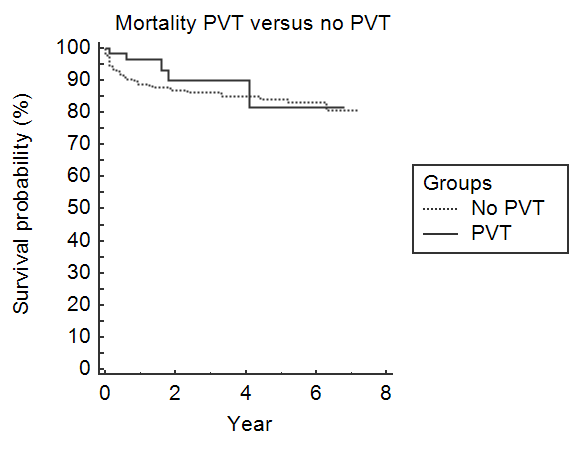Large Series Of Liver Transplantation In Patients With Portal Vein Thrombosis
Lahey Hospital & Medical Center, Burlington, MA
Meeting: 2019 American Transplant Congress
Abstract number: C353
Keywords: Liver transplantation, Outcome, Portal veins
Session Information
Session Name: Poster Session C: Surgical Issues: All Organs
Session Type: Poster Session
Date: Monday, June 3, 2019
Session Time: 6:00pm-7:00pm
 Presentation Time: 6:00pm-7:00pm
Presentation Time: 6:00pm-7:00pm
Location: Hall C & D
*Purpose: Portal vein thrombosis (PVT) is common in the cirrhotic population and no longer considered an absolute contraindication to liver transplantation in most centers.
*Methods: Retrospective analysis of 500 consecutive cases of liver transplantation from 2011-2018 at a single center. Characteristics and long-term outcomes of patients with portal vein thrombosis (PVT; n=64) confirmed at the time of liver transplantation were compared with patients transplanted without portal vein thrombosis (noPVT; n=436).
*Results: Recipients in the PVT group were older (59 vs 56 years; p<0.05). There was no statistically significant difference in the 2 groups in the proportion of male patients, BMI, incidence of diabetes mellitus or malignancy, and pre-transplant functional status. The PVT group waited longer for their liver transplantation (336 vs 228 days; p<0.05). The mean MELD score was 24 vs 26 (PVT vs noPVT; p=0.13). Similar proportion of recipients in both groups received living donor vs deceased donor grafts. 42% of thrombi were unsuspected on pre-operative imaging and detected intraoperatively, 35.9% were occlusive thrombus and 15.6% had clot extension into the SMV or splenic vein. 63 patients underwent an eversion thrombectomy; in 2 of these patients, flow could not be reestablished and their graft portal veins were anastomosed to varices in the area of the liver hilum. There were no tumor thrombi on pathological analysis. There was no significant difference in the cold ischemic time, length of hospital stay, or incidence of early graft failure. Patients in the PVT group had a significantly higher rate of post-operative portal vein thrombosis formation (4.7% vs 0.46%; p=0.002). 5-year patient survival were similar between the 2 groups.
*Conclusions: 12.8% of liver transplants in our center were performed in patients with PVT. Adequate flows can be reestablished in most patients with eversion thrombectomy and long-term survival is comparable with patients transplanted without PVT.
To cite this abstract in AMA style:
Cheah Y, Simon CJ, Jenkins RL, Akoad ME. Large Series Of Liver Transplantation In Patients With Portal Vein Thrombosis [abstract]. Am J Transplant. 2019; 19 (suppl 3). https://atcmeetingabstracts.com/abstract/large-series-of-liver-transplantation-in-patients-with-portal-vein-thrombosis/. Accessed January 1, 2026.« Back to 2019 American Transplant Congress

